Whitby Mudstone
The Whitby Mudstone is a Toarcian (Early Jurassic; Falciferum-Bifrons in regional chronostratigraphy) geological formation in Yorkshire and Worcestershire, England.[1] The formation, part of the Lias Group, is present in the Cleveland and Worcester Basins and the East Midlands Shelf.
| Whitby Mudstone Stratigraphic range: Toarcian (Falciferum-Bifrons) ~183–176 Ma | |
|---|---|
.jpg.webp) East Cliff near Whitby | |
| Type | Geological formation |
| Unit of | Lias Group |
| Sub-units | Members:
|
| Underlies | Inferior Oolite or Ravenscar Groups Or Blea Wyke, Dogger or Bridport Sand Formations |
| Overlies | Marlstone Rock or Cleveland Ironstone Formations |
| Thickness | Up to 120 m (390 ft) |
| Lithology | |
| Primary | Mudstone |
| Other | Siltstone |
| Location | |
| Coordinates | 54.5°N 0.6°W |
| Approximate paleocoordinates | 42.5°N 9.3°E |
| Region | Yorkshire, Worcestershire |
| Country | |
| Extent | Cleveland & Worcester Basins & East Midlands Shelf |
| Type section | |
| Named for | Whitby |
| Location | Coastal exposures from Hawsker Bottoms to Whitby Harbour |
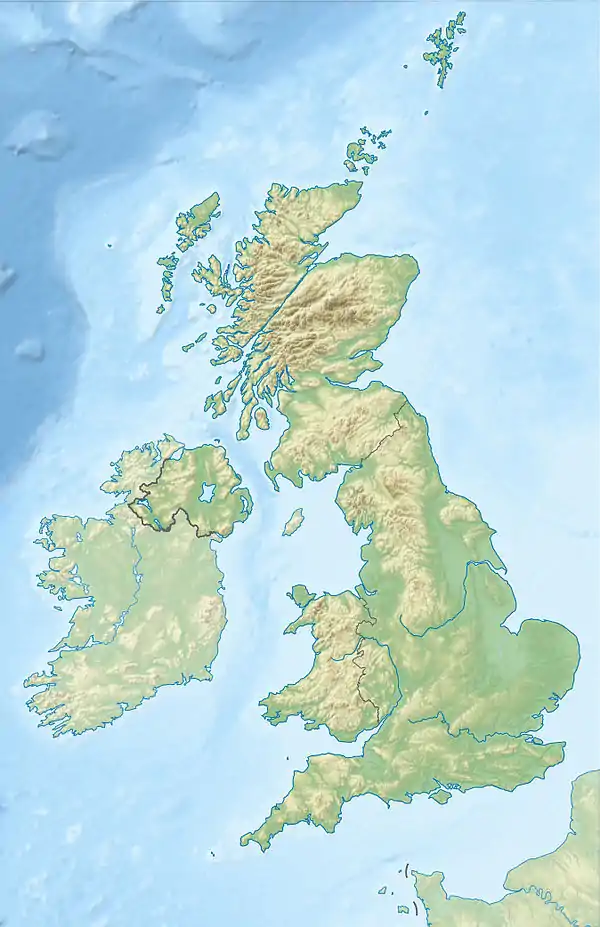 Whitby Mudstone (the United Kingdom) 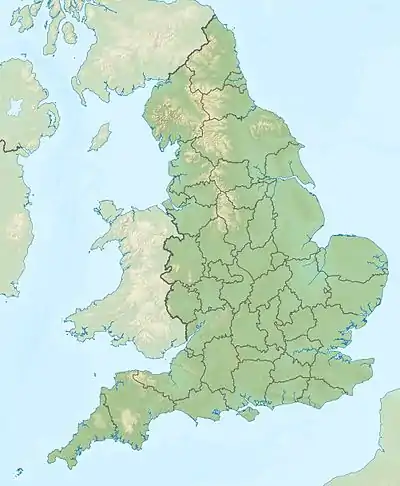 Whitby Mudstone (England) | |
Lithology
The formations consists of mudstone and siltstone, partly laminated and bituminous, medium to dark grey in colour, with rare fine grained calcareous sandstone beds. Limestone and phosphatic nodules are present at some levels.[2]
Fossil content
Dinosaur remains are among the fossils that have been recovered from the formation, although none have yet been referred to a specific genus.[3][4] One of the more notable discoveries is the skull of the pterosaur Parapsicephalus, found within the Alum Shale[note 2] Member.[5]
Vertebrates
| Vertebrates of the Whitby Mudstone Formation | ||||||
|---|---|---|---|---|---|---|
| Genus | Species | Location | Stratigraphic position | Abundance | Notes | Images |
| cf. Campylognathoides | Indeterminate | Winterton | Falciferum Zone | NHMUK PV R 36712, Humerus[6] | A pterosaur | |
| Hauffiosaurus | H. longirostris | Whitby-Saltwick | Falciferum Zone | MCZ 1033, a skeleton | A Rhomaleosaurid | |
| Microcleidus | M. homalospondylus | Whitby | Upper Alum Shale, Hildoceras bifrons Zone | Mutliple partial skeletons | Microcleidid plesiosaur |  |
| Macrospondylus | M. bollensis | Harpoceras serpentinum Zone | Several partial skeletons | Teleosaurid | ||
| Mystriosaurus | M. laurillardi | Whitby | Skull and lower jaws[7] | Teleosaurid, formerly considered to be the holotype of "Steneosaurus" brevior | 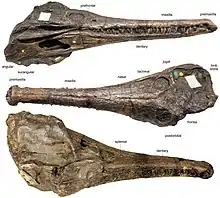 | |
| Parapsicephalus | P. purdoni | Loftus Alum Shale Quarry, Saltwick Bay (referred material) | Upper Alum Shale Member | Single partial skull lacking the snout (GSM 3166), tentantive referral of a humerus and scapulocoracoid (NHMUK PV R36634).[8] | A Rhamphorhynchid pterosaur | 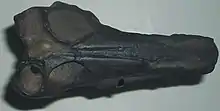 |
| Pelagosaurus | P. typus | Whitby | Alum Shale | Thalattosuchian | ||
| Rhomaleosaurus | R. thorntoni | Kingsthorpe Hollow | Upper | NHMUK PV Rr4853, a single mostly complete skeleton | A Rhomaleosaurid |  Rhomaleosaurus cramptoni holotype cast |
| R. zetlandicus | Loftus (also Lofthouse) Alum Mine | Alum Shale Member | YORYM G503, a partial skeleton[9] | |||
| R. cramptoni | Alum quarry, Kettleness | NMING F8785, a partial skeleton | ||||
| Plagiophthalmosuchus | P. gracilirostris | Whitby | Teleosaurid | 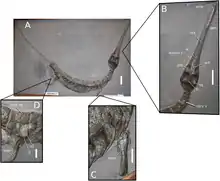 | ||
| ?Theropoda | Indeterminate | Femur, currently lost[10] | ||||
Insects
Insect compression fossils are known from nodules found on Alderton Hill near Alderton and Dumbleton in Gloucestershire, including Alderton Hill Quarry and other nearby localities.[11]
See also
- List of fossiliferous stratigraphic units in England
- Toarcian turnover
- Toarcian formations
Notes and references
Notes
- Not to be confused with the Ordovician Alum Shale Lagerstätte of Sweden
- Not to be confused with the Ordovician Alum Shale Lagerstätte of Sweden
References
- Whitby Mudstone at Fossilworks.org
- "Whitby Mudstone Formation". The BGS Lexicon of Named Rock Units. British Geological Survey.
- "Whitby Mudstone Formation". The BGS lexicon of named rock units. British Geological Survey. Retrieved 1 November 2016.
- Weishampel et al., 2004, pp. 517-607
- O'Sullivan & Martill, 2017
- O’Sullivan, Michael; Rigby, Martin (April 2017). "The first evidence of a Campylognathoides —like pterosaur in the Toarcian (Lower Jurassic) Whitby Mudstone Formation of Lincolnshire, England". Proceedings of the Geologists' Association. 128 (2): 287–291. doi:10.1016/j.pgeola.2016.12.009.
- Sachs, S.; Johnson, M.M.; Young, M.T.; Abel, P. (2019). "The mystery of Mystriosaurus: Redescribing the poorly known Early Jurassic teleosauroid thalattosuchians Mystriosaurus laurillardi and Steneosaurus brevior" (PDF). Acta Palaeontologica Polonica. 64 (3): 565–579. doi:10.4202/app.00557.2018.
- O'Sullivan, Michael; Martill, David M.; Groocock, David (December 2013). "A pterosaur humerus and scapulocoracoid from the Jurassic Whitby Mudstone Formation, and the evolution of large body size in early pterosaurs". Proceedings of the Geologists' Association. 124 (6): 973–981. doi:10.1016/j.pgeola.2013.03.002.
- Taylor, M. A. (May 1992). "Taxonomy and taphonomy of Rhomaleosaurus zetlandicus (Plesiosauria, Reptilia) from the Toarcian (Lower Jurassic) of the Yorkshire coast". Proceedings of the Yorkshire Geological Society. 49 (1): 49–55. doi:10.1144/pygs.49.1.49. ISSN 0044-0604.
- Benton, M. J.; Spencer, P. S. (1995), "British Early Jurassic fossil reptile sites", Fossil Reptiles of Great Britain, Dordrecht: Springer Netherlands, p. 118, doi:10.1007/978-94-011-0519-4_5, ISBN 978-94-010-4231-4
- Kelly, Richard S.; Ross, Andrew J.; Coram, Robert A. (2018). "A Review of Necrotauliids from the Triassic/Jurassic of England (Trichoptera: Necrotauliidae)". Psyche: A Journal of Entomology. 2018: 1–12. doi:10.1155/2018/6706120. ISSN 0033-2615.
Bibliography
- O'Sullivan, Michael, and David M. Martill. 2017. The taxonomy and systematics of Parapsicephalus purdoni (Reptilia: Pterosauria) from the Lower Jurassic Whitby Mudstone Formation, Whitby, U.K. Historical Biology 29. 1009–1018. Accessed 2020-03-12. doi:10.1080/08912963.2017.1281919
- Weishampel, David B.; Peter Dodson, and Halszka Osmólska (eds.). 2004. The Dinosauria, 2nd edition, 1–880. Berkeley: University of California Press. Accessed 2019-02-21.ISBN 0-520-24209-2
Further reading
- M. O'Sullivan, D. M. Martill, and D. Groocock. 2013. A pterosaur humerus and scapulocoracoid from the Jurassic Whitby Mudstone Formation, and the evolution of large body size in early pterosaurs. Proceedings of the Geologists' Association
- A. S. Smith and G. J. Dyke. 2008. The skull of the giant predatory pliosaur Rhomaleosaurus cramptoni: implications for plesiosaur phylogenetics. Naturwissenschaften 95:975-980
- M. J. Benton and M. A. Taylor. 1984. Marine reptiles from the Upper Lias (Lower Toarcian, Lower Jurassic) of the Yorkshire coast. Proceedings of the Yorkshire Geological Society 44(4):399-429
- F. v. Huene. 1926. The carnivorous Saurischia in the Jura and Cretaceous formations, principally in Europe. Revista del Museo de La Plata 29:35-167
- C. W. Andrews. 1922. Note on the skeleton of a large plesiosaur (Rhomaleosaurus thorntoni, sp. n) from the Upper Lias of Northamptonshire. Annals and Magazine of Natural History 10:407-415
- R. Tate and J. F. Blake. 1876. The Yorkshire Lias 1-475